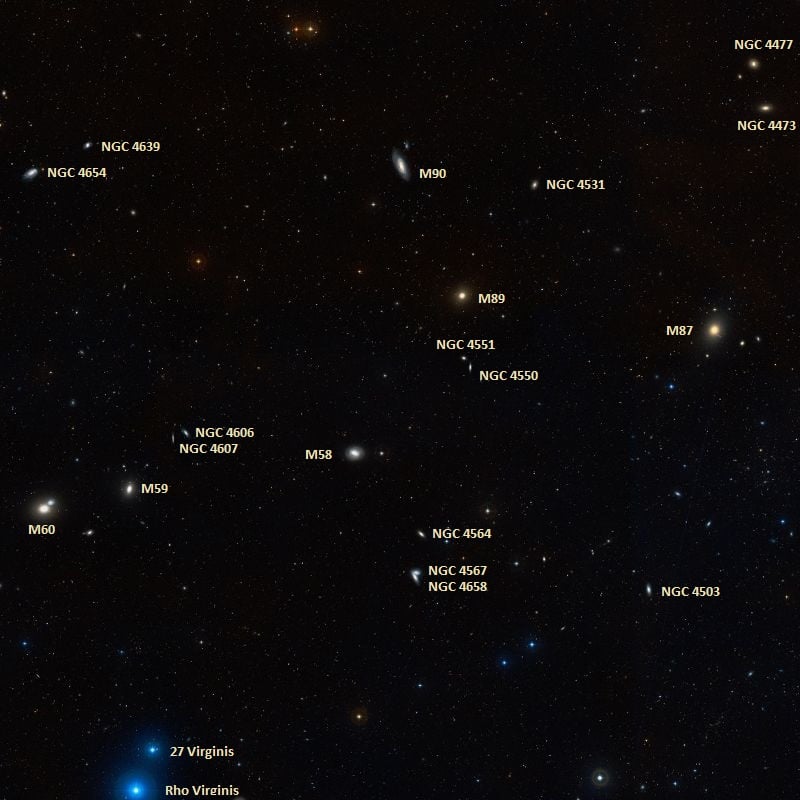Welcome back to Messier Monday! Today, we continue in our tribute to our dear friend, Tammy Plotner, by looking at the barred spiral galaxy, Messier 58.
In the 18th century, while searching the night sky for comets, French astronomer Charles Messier kept noting the presence of fixed, diffuse objects in the night sky. In time, he would come to compile a list of approximately 100 of these objects, with the purpose of making sure that astronomers did not mistake them for comets. However, this list – known as the
Messier Catalog
– would go on to serve a more important function, becoming one of the first catalogs of Deep Sky Objects.
One of these objects is the intermediate barred spiral galaxy known as Messier 58, which is located approximately 68 million light years away in the
Virgo constellation
. In addition to being one of just four barred spiral galaxies in the
Messier Catalog
, it is also one of the brightest galaxies in the
Virgo Supercluster
. Due to its proximity in the sky to other objects in the Virgo Galaxy Field, it can be seen only with the help of a telescope or a pair of large binoculars.
Description:
This beautiful old barred spiral galaxy located approximately 68 million light-years from Earth. Although it might appear pretty plain, it has some great things going for it... namely an active galactic nucleus. As Marcella Contini indicated in a
2004 study
:
[caption id="attachment_137523" align="aligncenter" width="580"]
The Messier 58 barred spiral galaxy. Credit: Adam Block/Mount Lemmon SkyCenter/University of Arizona
[/caption]
Yet where is this gas traveling to and why? According to
2014 study
by S. Garcia-Burillo (et al):
What causes inward transport of gases? Why, a massive gravity pull of course. And what could be more gravitational attractive than a black hole! As Eliot Quataert (et al) indicated in their
1999 study
:
Galaxy NGC 4579 was captured by the Spitzer Infrared Nearby Galaxy Survey (SINGS) Legacy Project using the Spitzer Space Telescope's Infrared Array Camera (IRAC). In this image, the red structures are areas where gas and dust are thought to be forming new stars, while the blue light comes from mature stars. This SINGS image is a four-channel, false-color composite, where blue indicates emission at 3.6 microns, green corresponds to 4.5 microns, and red to 5.8 and 8.0 microns. The contribution from starlight (measured at 3.6 microns) in this picture has been subtracted from the 5.8 and 8 micron images to enhance the visibility of the dust features.
[caption id="attachment_137522" align="aligncenter" width="580"]
Messier 58 (NGC 4579), as imaged by the Spitzer Infrared Nearby Galaxy Survey (SINGS) Legacy Project using the Spitzer Space Telescope's Infrared Array Camera (IRAC). Credit: NASA/JPL-Caltech/R. Kennicutt (University of Arizona) and the SINGS Team
[/caption]
History of Observation:
When Charles Messier discovered this one on April 15, 1779, I'm sure he didn't know he was looking back into time when he wrote:
Messier 58 may not have been a comet, but it certainly was another distant cousin of our own Milky Way!
Locating Messier 58:
Finding M58 requires a telescope or large binoculars, and lots of patience. Because the Virgo Galaxy field contains so many galaxies which can easily be misidentified, it is sometimes easier to "hop" from one galaxy to the next! In this case, we need to start by locating bright Vindemiatrix (Epsilon Virginis) almost due east of Denebola. Let's hop four and a half degrees west and a shade north of Epsilon to locate one of the largest elliptical galaxies presently known - M60.
At a little brighter than magnitude 9, this galaxy could be spotted with binoculars, but stick with your telescope. In the same low power field (depending on aperture size) you may also note faint NGC 4647 which only appears to be interacting with M60. Also in the field to the west (the direction of drift) is our next Messier, bright cored elliptical M59. Now we will need to continue about an average eyepiece field of view, or a degree further west of this group to bring you to our "galactic twin", fainter M58.
[caption id="attachment_137520" align="aligncenter" width="580"]
The location of M58, in the direction of the Virgo constellation. Credit: IAU
[/caption]
In a smaller telescope, do not expect to see much. What will appear at low power is a tiny egg-shaped patch of contrast change. As aperture increases, so does detail and a bright nucleus will begin to appear as you move into the 4-6" size range and dark sky locations. As with all galaxies, dark skies are a must!
And here are the quick facts on this object to help you get started:
- Object Name
-
Messier 58
- Alternative Designations
-
M58, NGC 4579
- Object Type
-
SBc Galaxy
- Constellation
-
Virgo
- Right Ascension
-
12 : 37.7 (h:m)
- Declination
-
+11 : 49 (deg:m)
- Distance
-
60000 (kly)
- Visual Brightness
-
9.7 (mag)
- Apparent Dimension
-
5.5x4.5 (arc min)
We have written many interesting articles about Messier Objects here at Universe Today. Here's Tammy Plotner's
Introduction to the Messier Objects
,
M1 – The Crab Nebula
, and David Dickison's articles on the
2013
and
2014
Messier Marathons.
Be to sure to check out our complete
Messier Catalog
. And for more information, check out the
SEDS Messier Database
.
Sources:
 Universe Today
Universe Today
